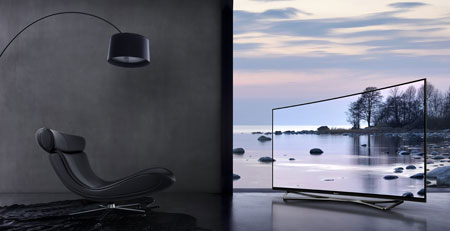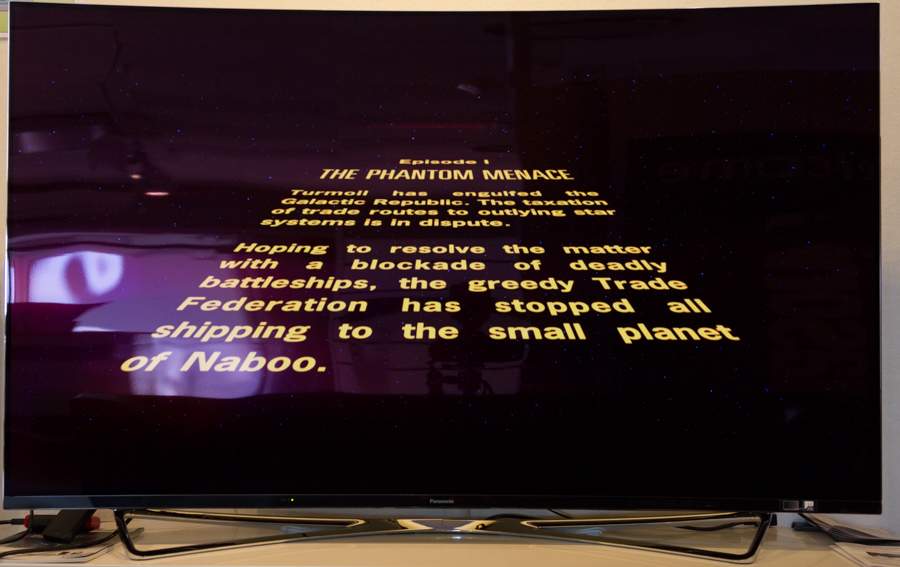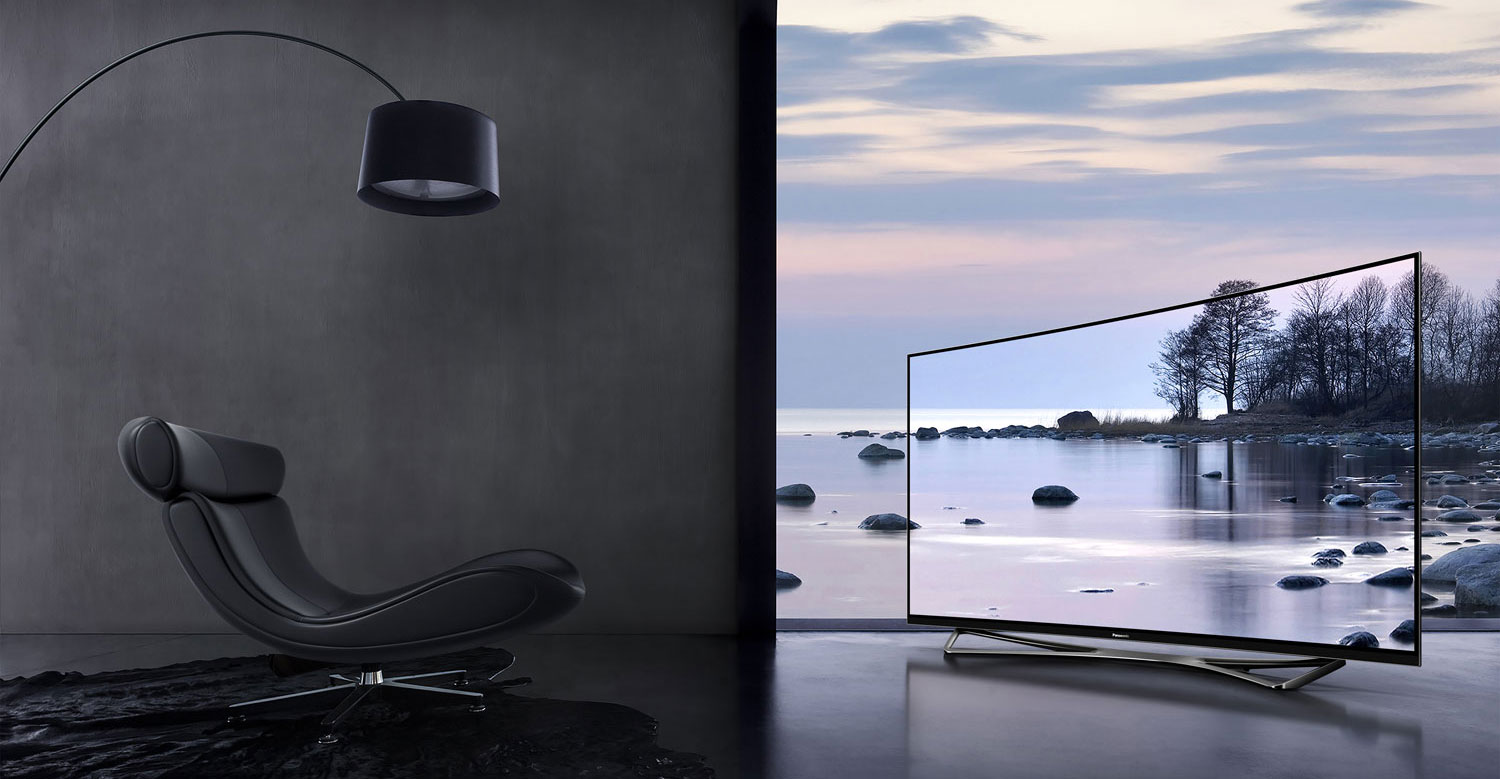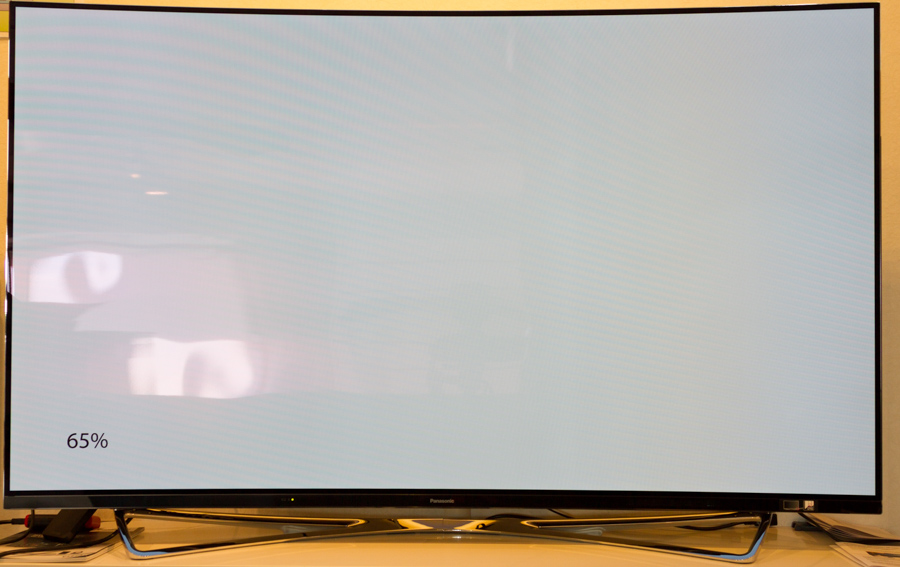Review: Panasonic CZ950 (4K OLED)
At IFA, Panasonic launched its first OLED TV and the company is clearly excited about the new 65-inch curved TV. Panasonic believes that it has produced the best picture quality to date. However, the TV is also pricey, surpassing even some luxury Bang & Olufsen TVs. One of the first TVs produced is currently in Europe and FlatpanelsHD had an exclusive chance to spend half a day with the TV for testing, measuring and evaluating. We prepared well and went through most of our usual procedures so here are our findings.
Panasonic CZ950 is not yet available but is expected to cost approximately 10.000 Euro (65").Price and retailers:
Disclaimer
Since we did not examine the TV under controlled conditions we were not able to examine it as thoroughly as we usually do. Consider this a "mini review" and not a full in-depth review. For the same reason, not all of our photos are great.Specifications
65" Ultra HD (3840x2160)
HDR (high dynamic range) with firmware update
Larger color space (90% DCI)OLED Passive 3D Stand (fixed)
VESA wall bracket(WxHxD) 144,8 x 84,7 x 11,5 cm (without stand) 27 kg HDMI (4x 2.0)
USB (3x)
Ethernet
2x CIOptical
HDMI-ARC (1x)
Headphones
Analog outputs2.0 stereo DVB T/T2/C/S2
WiFi (ac standard)MPEG4
HEVC
VP92014 operating system (Smart Viera) Remote Manual
RemoteSubscribe to our Newsletter, Facebook, twitter or RSS to receive notice when new reviews are publishedFirst impressions
Panasonic CZ950 shares many characteristics with LG EG960. Both are elegantly-designed 65-inch curved TVs with a white back. CZ950 has the same incredibly thin profile but the electronics box is slightly taller and thicker. There is a cover included for hiding cables and connections and the box is covered in alcantara, a form of artificial leather.
We hope that manufacturers will soon start moving the hardware and ports into an external box to make the ultra-thin TVs really stand out.
The stand of CZ950 is made from solid metal and feels quite stable.
We found some of the ports on the TV’s left side, including USB and 1x HDMI (out of 4). The rest are hidden behind the back cover, where we also found the antenna connection and LAN port. All of them point in the right direction; down. You can also mount the TV on a wall but be aware that you will have to remove the alcantara cover first since the mounting holes are hidden underneath.
The bezel looks a lot like LG’s. It is a thin metal bezel with a black inner border around the OLED panel. We did not try to move the TV during the review so we cannot comment on its weight but reading the specifications list it appears that it is almost 10 kilograms heavier, including the stand, than LG’s EG960.
The amount of reflections is also similar to EG960 and the curve helps reduce it somewhat if you sit in sweet spot. The screen is very bright and despite some reflections it is well-suited for brightly lit rooms such as modern living rooms. I must repeat that this benefit should be the primary reason for making a curved display in the first place as we already know that it does little good in general.User experience & Features
Since this is a mini-review we can’t really comment on daily use of the TV and its various features. We mostly skipped this step of our evaluation to focus on picture quality but one thing that might surprise you is that Panasonic has chosen not to use its new TV operating system in CZ950.Operating system & smart-TV
We have had the pleasure of using Firefox OS on several occasions. It is the new operating system of Panasonic’s 2015 Smart TVs. It is therefore strange and disappointing that Panasonic is using its old 2014 operating system (Smart Viera) in its most expensive TV. The Smart Viera platform is simply not very good. We will not go in-depth with it here since it is unchanged from the 2014 TVs but we certainly don’t understand the decision. Why is Firefox OS not included in CZ950? Is Panasonic already abandoning the new operating system? We’ll follow up on this.
We should probably add that you still have the usual apps such as Netflix and YouTube. The TV also supports HEVC, meaning that you can stream 4K from Netflix, but the 4K stream on YouTube is not active yet. If you want more options you can buy and connect an external media player such as the Nvidia Shield or the new 4K Amazon Fire TV. It is also worth remembering that Firefox OS has yet to replace all of Panasonic’s menus in the other 2015 TVs so some sections of CZ950 looks identical to other 2015 models.Remote control & operating
We did not have a chance to look at the bundled remote and instead we were offered the traditional Panasonic remote, which is bundled with all TVs.TV channels, recording & audio
The TV received a 4K satellite broadcast signal and it looked great but since we did not have a chance to set it up in our usual controlled environment we can’t add much regarding tuner, recording and similar capabilities. However, we have no reason to believe that the features are any different compared to Panasonic’s other TVs.
It is not fair to evaluate sound quality based on a showroom demo either so we will refrain from doing that. The TV was connected to a Panasonic sound system for demonstration purposes.Calibration
Based on my experience with Panasonic’s CX800, I started by switching to the Cinema profile. However, that was a wasted effort. After a full calibration in the Cinema profile, I switched to the THX Cinema profile, which - apart from a slightly low brightness level - delivered great results with colors of dE of 1 or lower at all greyscale steps. From here it was very simple to slightly tweak the brightness level to hit approximately 130 cd/m2 on a white ABL pattern.
In other words, color accuracy is spot-on. Panasonic has clearly gone to great lengths to optimize the OLED panel. We are back to the good ol’ plasma days where one color profile is all we need.
Note: We did not have enough time to calibrate the TV for the larger DCI color space so here we have just included a graph. The graph illustrates how much of the DCI P3 color space Panasonic’s OLED can cover (when using the DCI P3 setting option). As you can see it is still missing quite a lot in the green range to be able to claim full support for DCI P3.Measurements
In this new "measurement" section we will include all measurements and our suggested calibration settings. If you want to learn more about our test methodology click here.
Measurements Out-of-box Calibrated Black level 0 cd/m2 0 cd/m2 Brightness 265 cd/m2 130 cd/m2 Contrast Infinite Infinite Input lag - -
Power consumption Out-of-box Calibrated On 280 W 220 W Stand-by 0.25 W -
Group Setting Value Picture Profile THX Cinema Backlight 33 Contrast 60 Brightness 0 Sharpness 50 Color 50 Tone 0 Advanced Color temp Warm2 Vivid colors Off Adaptiv backlight Off Light sensor Off Noise reduction Off MPEG Remaster Off Resolution Remaster Off Intelligent Frame Control Minimum/Medium Game mode On/Off
The calibrated settings are mostly just a result of switching to the THX Cinema profile and increasing the backlight setting a bit. To avoid motion stutter you might want to enable the IFC (Intelligent Frame Creation) system and set it to minimum or medium (too many artefacts for our taste).
Our energy consumption measurements came in slightly higher than on LG’s EG960 but since it is OLED energy consumption depends a lot on the type of picture content.Picture quality
"Panasonic" and "OLED" in the same sentence… We know that many of you have been waiting impatiently for this day. LG has now started selling its OLED panels to other manufacturers so the big question here is of course if Panasonic can improve things further by optimizing picture processing. And judging by our findings in the calibration section you must be eager to hear more.
First off, I want to reiterate that the TV was placed in a showroom, which makes it hard to assess areas such as black crush and white crush. However, it was quickly confirmed that CZ950 does not suffer from the same artefacts on dark grayscale (5 IRE) patters that LG EG960 did. The dark tones are generally clean and shadow details look great.
CZ950 does not support HDR yet. It will be enabled by a later firmware update (HDMI 2.0a should work now but we can't confirm that since there are no UHD BD players on the market). We cannot comments on specifics but once again we can probably assume that it will have many of the same characteristics that we saw on LG EG960 (which supports HDR now). On CZ950, we measured peak white (10% window) to approximately 450 cd/m2. Full-screen white comes in at around 150 cd/m2, which is identical to LG EG960. We see the same contrast-rich images and 4K video is beautiful.
Read our backgrounder on HDR
Read our backgrounder on Ultra HD & wide color gamuts
As we touched on in our review of EG960, HDR starts to make sense when combined with OLED technology. The OLED panel can reproduce the full brightness range from peak highlights to deep shadows in every single pixel. If you want very bright colors, for example a sun, in only a small area of the picture, you can have that. As said, there is no support for HDR in CZ950 yet and it did not recognize our HDR clips stored on USB either but there is certainly big potential here. We will have to evaluate that at a later point - hopefully when the new UHD Blu-ray players start hitting the market.
Motion reproduction is slightly better on CZ950 than on EG960. It did not correctly render all of our test patterns designed to stress the TV but since these were developed to stress test plasma TVs it does not concern us much. Panasonic seems to have optimized the OLED panel and managed to improve motion reproduction somewhat and that is the important point here.
We had brought some recordings of football matches for the review and the TV performed admirably. We did not notice any banding on the panel and no particular blurring around players. However, be aware that the IFC system will introduce artefacts, especially when panning over the stadium crowd. Using IFC is a dilemma between sacrificing a little motion resolution and having more artefacts. Setting IFC to "off" will introduce some stuttering in the picture, so most users will probably prefer to use the "minimum" option for IFC.
Like many other 2015 TVs, Panasonic’s OLED offers support for an extended color space (see the DCI P3 graph in the calibration section). And we can once again conclude that yes, CZ950 supports an extended color space but no, there is not much benefit in that at the moment. There is simply no content available on the consumer market. We must wait for UHD Blu-ray movies and for streaming services to offer HDR content. The TVs are here so come on!
As you might have read, we were able to find retention (a channel logo) on LG EG960 by using a camera technique but since CZ950 is brand new there was nothing to see. However, since this is the exact same panel, we certainly can’t rule out the risk. Just like plasma TVs, including the legendary Kuro, OLED displays are self-emissive, which means that each pixel can age differently.
On the other hand we did see two horizontal lines in the middle of the panel, approximately 1 cm apart. It was only visible on a uniform grey background so it is not a big concern.
We usually finish off by taking photos of light/black homogeneity but since we tested the TV in a showroom and since the TV is capable of reproducing perfect black, it makes no sense. It is easy to see the reflections of the environment in most of your photos. Instead, we offer you a 65% white photo.
Our input lag tester, Leo Bodnar, acted up for some reason. It simply gave readings that were far too low compared to what we could see and feel by moving around a mouse cursor on the screen. Panasonic must have implemented some picture process that confuses our equipment. However, it was fairly easy to confirm that the TV does indeed have some degree of input lag and likely in the same range as LG’s TV - perhaps a bit higher. The game mode improves things quite a bit but we could confirm that input lag was still noticeable by using a mouse pointer. If you buy this TV at retail price you are most likely buying it to enjoy 4K HDR movies so the gaming performance might not be a major concern.Conclusion
We only spent about 4 hours with Panasonic’s CZ950 OLED TV but we had prepared well and managed to run through most of our usual tests and evaluations. There is no doubt here; this is a reference-class TV. The colors are spot-on, black is black, details are great, and the TV can go very bright. We even found that Panasonic has improved motion resolution, so it ticks off all the right boxes.
However, CZ950 does not yet fully support HDR (will be added later through a firmware update, HDMI 2.0a should work now though) and for some strange reason Panasonic has decided not to include its current TV operating system, Firefox OS, instead going with last year’s subpar OS. This is not a positive sign for Panasonic’s commitment to Firefox OS. And one can’t really ignore the fact that Panasonic’s TV is almost twice as expensive as LG’s EG960 that uses the same OLED panel. Picture characteristics are large the same. LG also offers a much better operating system with webOS so CZ950 is simply far behind on user experience.
Our mini-review is not complete enough to examine every detail of CZ950 and we cannot guarantee that some issues might not lurk beneath the surface that will only be discovered after prolonged use. We have no doubt that CZ950 offers reference-class picture quality and in several areas it is superior to LG EG960 but since it has no support for HDR and because we only had about 4 hours with the TV we cannot comfortably give it our Reference Award. We need to examine the TV in a controlled environment to reach a conclusion.Compare prices for Panasonic CZ950 on Pricerunner
Price and retailers:
Picture quality is assessed as overall picture quality, including color reproduction, image processing, contrast, motion etc.
Features is an evaluation of the built-in functionality such as apps, connector ports, tuners, recording capabilities, decoder formats, and how useful they are, as well as sound quality.
User experience is evaluated on the basis of user friendliness, speed, build quality, and day-to-day use of the TV
Total score is weighted: 50% Picture quality, 25% Features, 25% User experience.
All scores are calculated based on a moving maximum target, defined by what we currently consider the best on market. It is then presented as a percentage. This means that a score will fall over time as new and better TVs set new standards. This allows you to compare scores across years. A score of 100% in a given category means that it is consider the best available product in this category to date.Click for a more detailed explanation of the score system and our Awards
Reference picture quality
Perfect black
Wide viewing angles
Very accurate colors
Great reproduction of all grey tonesNo HDR yet
2014 operating system
IFC introduces artefacts but is required to improve motion
Input lag
Curved
Risk of burn-inNearest competitors
























